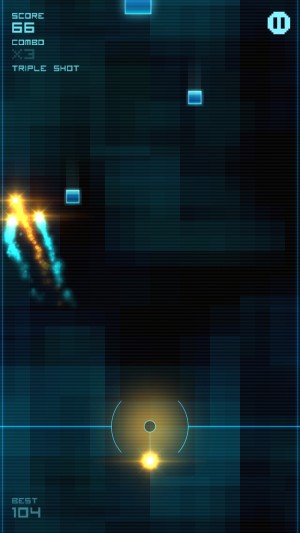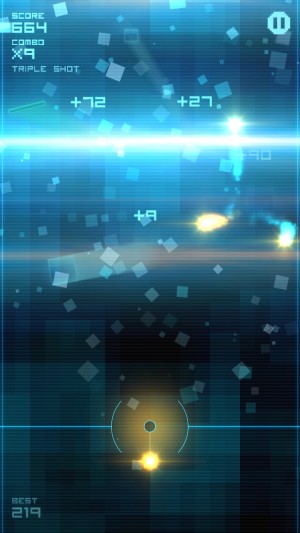 It’s been interesting watching the way shooting games have progressed over the years. As one of the first genres in video gaming, the shooting genre has had a lot of interesting twists and turns. From the earliest titles like Space Invaders that offered a single screen and a big set of targets to pick off one at a time, to the advent of scrolling shooters with titles like Namco’s Xevious, into a golden age with amazing shooting games being made by just about every prominent company, often with intricate stage designs and power-up systems. This was followed by the near-total death of the genre that coincided with the rise of Cave who, along with developers like Treasure and Psikyo, continued to service the shrinking audience with increasingly intricate and complex games. The once-mighty genre seemed consigned to niche status forever.
It’s been interesting watching the way shooting games have progressed over the years. As one of the first genres in video gaming, the shooting genre has had a lot of interesting twists and turns. From the earliest titles like Space Invaders that offered a single screen and a big set of targets to pick off one at a time, to the advent of scrolling shooters with titles like Namco’s Xevious, into a golden age with amazing shooting games being made by just about every prominent company, often with intricate stage designs and power-up systems. This was followed by the near-total death of the genre that coincided with the rise of Cave who, along with developers like Treasure and Psikyo, continued to service the shrinking audience with increasingly intricate and complex games. The once-mighty genre seemed consigned to niche status forever.
Luckily, there was something of a retro boom several years ago, and even more luckily, one of the original companies behind the genre was there with a great idea, perhaps their best in decades. Taito’s Space Invaders Extreme offered up shooting action far more simple on its surface than any of its recent contemporaries, wrapped up in an excellent retro-future presentation. It was pretty enough to attract eyeballs, but it was straightforward enough to bring in people who hadn’t touched a shooting game in years. It caused a temporary resurgence for Taito who, like the shooting genre itself, hadn’t been terribly relevant for years. Soon, there were all sorts of shooting games following a similar style, revitalizing a near-dead genre. We still see lots of shooting games today subscribing to one aspect or another of Space Invaders Extreme. What gets less attention is Taito’s similar attempt at the time to bring Arkanoid back to life, an endeavor that didn’t end quite so well.
 Whether by serendipity or deliberate choice, Blokshot Revolution (Free) feels very much like a marriage of those two retro revivals. Like Arkanoid, your goal is to launch a projectile from the bottom of the screen to hit blocks above you, removing them from the field. You have to pay careful attention to angles and how your shots will rebound if you want to rack up a nice score. There are some big differences, though. Critically, the blocks aren’t stationary. They descend, slowly at first, but more quickly as you go on, and as in Space Invaders, if one of them touches the bottom of the screen, you’re finished. Furthermore, you don’t control a paddle that moves back and forth along the bottom. Instead, you operate a sort of trebuchet that catapults a shot when you touch and release the screen. As it can’t move around, your ability to hit the incoming objects depends entirely on timing your shots so that they’ll fire at the desired angle.
Whether by serendipity or deliberate choice, Blokshot Revolution (Free) feels very much like a marriage of those two retro revivals. Like Arkanoid, your goal is to launch a projectile from the bottom of the screen to hit blocks above you, removing them from the field. You have to pay careful attention to angles and how your shots will rebound if you want to rack up a nice score. There are some big differences, though. Critically, the blocks aren’t stationary. They descend, slowly at first, but more quickly as you go on, and as in Space Invaders, if one of them touches the bottom of the screen, you’re finished. Furthermore, you don’t control a paddle that moves back and forth along the bottom. Instead, you operate a sort of trebuchet that catapults a shot when you touch and release the screen. As it can’t move around, your ability to hit the incoming objects depends entirely on timing your shots so that they’ll fire at the desired angle.
The game plays like a dream. Touching and holding the screen starts swinging your shot around in a circle. Removing your finger from the screen launches the shot. The longer you hold your finger down, the harder and faster the shot will be when you let it go. It only takes a little practice to get the hang of aiming your shots, but it takes a lot more to do it consistently. With ricochets playing a major role in getting a good score and earning valuable power-ups, harder shots are very desirable, but you have to consider the risks involved in the extra wind-up time. Sometimes you’ll need to fire off several quick shots to clear immediate danger. As an extra twist, you can only have one shot on the screen at a time. You can wind up your next shot, but as soon as you release it, the previous bullet will disappear, making rapid fire difficult at anything but very close range.
 You’ll want to set up those nice combos, too. Not just for the points or their benefit in clearing the screen, but also for the power-ups. Rack up a decent combo and you’ll earn a triple shot that fires out in a spread, each bullet ricocheting around on its own. It only lasts a short while, but while you’ve got it, it offers great stopping power. While the game starts off slowly, with large, slow squares that are pretty easy to pick off, you’ll soon be contending with tiny squares, longer pieces that are rotating around, and more. It eventually reaches a point where you’ll realize trying to take out one piece at a time is foolish, forcing you to learn the game’s nuances. I wish we could skip past the slow start after a few plays. Like most games of this type, once you’ve got the hang of it, you really just want to get right back where you left off as soon as possible. While restarts are extremely quick, you’ll still have to spend a little time shooting at the big pieces before things heat up again.
You’ll want to set up those nice combos, too. Not just for the points or their benefit in clearing the screen, but also for the power-ups. Rack up a decent combo and you’ll earn a triple shot that fires out in a spread, each bullet ricocheting around on its own. It only lasts a short while, but while you’ve got it, it offers great stopping power. While the game starts off slowly, with large, slow squares that are pretty easy to pick off, you’ll soon be contending with tiny squares, longer pieces that are rotating around, and more. It eventually reaches a point where you’ll realize trying to take out one piece at a time is foolish, forcing you to learn the game’s nuances. I wish we could skip past the slow start after a few plays. Like most games of this type, once you’ve got the hang of it, you really just want to get right back where you left off as soon as possible. While restarts are extremely quick, you’ll still have to spend a little time shooting at the big pieces before things heat up again.
The game is free to play, supported by ads. You can buy the game’s sole IAP for $1.99 to remove those ads forever. As an added bonus, you’ll also unlock the game’s full soundtrack, and that might be worth the price alone. There are quite a few songs in the unlocked version, with six different tracks. While they’re all from the electronic/house genre, they cover a wide variety of tempos and instrumentation, helping keep the game’s presentation fresh even as the visuals stay the same. You can choose whichever track you like from the pause menu, or you can simply let the game randomly shuffle through them. Blokshot also supports Game Center leaderboards, and the competition is pretty heavy already.
Blokshot Revolution is one of those brilliant titles that finds a central mechanic that feels good and runs all the way home with it. It’s exciting, tense, and has a great learning curve that keeps it fresh well beyond what you might expect from its somewhat simple premise. It takes skill, quick thinking, and a keen eye to win, and I love that your inevitable losses never feel unfair. You can always see things well enough ahead of time that you know you could have done something differently and survived. While it’s a bit threadbare in terms of options, play modes, and that sort of thing, it also doesn’t need any of it. What’s here is simply divine all on its own.